 |
|  |
 |
 |
Seven prime ministers held office between February 1938, when the first issue of Shashin Shuho was published, and July 1945: Fumimaro Konoe, Kiichiro Hiranuma, Nobuyuki Abe, Mitsumasa Yonai, Hideki Tojo, Kuniaki Koiso, and Kantaro Suzuki. The collection of Shashin Shuho issues up to issue No. 352 from December 20, 1944 that can be viewed on the JACAR site show photos of each cabinet, from Konoe through Koiso, at the time they were established (see “Timeline” for more details).
In addition, of the seven prime ministers listed above, Fumimaro Konoe and Hideki Tojo held office for relatively long terms. Along with being photographed when their respective cabinets were established, they often appeared on the pages of Shashin Shuho on many other occasions. This section will focus on Fumimaro Konoe, introducing photos of this prime minister along with other related documents.
|
 |
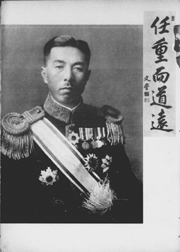 |
 |
The first issue of Shashin Shuho, which was published on February 13, 1938, featured a photo of then Prime Minister Fumimaro Konoe.
Fumimaro Konoe was born as the eldest son of the Konoe family, the head of Gosekke (the five regent houses) in 1891. He initially entered the Philosophy Department of Tokyo Imperial University to study philosophy, but soon moved to the College of Law, Kyoto Imperial University, where he studied mainly under Hajime Kawakami. In 1916, he became a member of House of Peers and started his career as a politician. In 1919, he accompanied the Japanese delegate Kinmochi Saionji to the Paris Peace Conference. He was elected as the Deputy Chairman of the House of Peers in 1931, and the Chairman of the House of Peers in 1933. He declined an order to form a cabinet immediately after the February 26th Incident in 1936, but ultimately became Prime Minister in June 1937 and established the first Konoe Cabinet. Soon after in July, fighting broke out between Japanese troops and Chinese troops at the Marco Polo Bridge, marking the start of the Sino-Japanese War. Later on January 16, 1938, Japan effectively terminated diplomatic relations with China by telling the Nanking Government that the Imperial government would no longer deal with it in future. |
 |
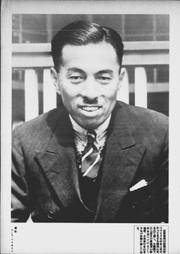 |
 |
The first Konoe Cabinet resigned en masse on January 4, 1939. A photo of a smiling Fumimaro Konoe appeared in issue No. 46 of Shashin Shuho from January 4, 1939, the same day as his resignation.
Document 1 is Prime Minister Konoe’s letter of resignation from January 4 (the third image and the fourth image). |
Konoe resigned from the post of Prime Minister on January 4, 1939, and was appointed President of the Privy Council the next day on January 5. After witnessing the successive cabinets of Hiranuma, Abe, and Yonai, Konoe resigned from his position as the Chairman of the Privy Council on June 24, 1940 and announced that he intended to launch a movement (the new regime movement) to create a new political structure. In the midst of these developments, the Yonai Cabinet resigned on July 16, and Konoe was once again ordered to form a cabinet the next day on July 17. The second Konoe Cabinet was formally established on July 22, 1940.
Document 2 is a document containing the announcement Konoe made when he resigned as the Chairman of the Privy Council and launched the new order movement.
Document 3 is a document that summarizes the requests made by various quarters in the political community to the newly established second Konoe Cabinet.
|
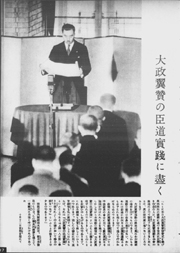 |
 |
After establishing his second cabinet, Konoe summoned leaders from all quarters to form a new regime movement preparatory committee on August 23. Following deliberations held by the committee, he established the Imperial Rule Assistance Association on October 12, 1940. The photo above depicts Konoe at the inaugural ceremony of the Imperial Rule Assistance Association.
Document 4 is a collection of documents that includes a typed copy of Konoe’s statement made at the new order movement preparatory committee on August 28, 1940 (left on the sixteenth image through the twenty-first image), as well as a letter of transmittal for “Quick overview of the new order” that explains the structure, characteristics, and other matters of the Imperial Rule Assistance Association (the thirty-sixth image and thirty-seventh image).
Document 5 is the “Quick overview of the new order” covered in special issue No. 208 of Shuho, which was published on October 7, 1940. |
|
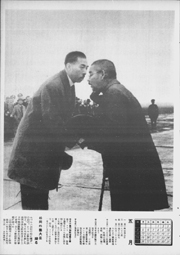 |
 |
The second Konoe Cabinet promoted the aforementioned new order movement in Japan, and pursued a foreign relations policy that culminated in the Tripartite Alliance between Japan, Germany, and Italy, which was established under the leadership of the Minister of Foreign Affairs Yosuke Matsuoka. He visited Germany on March 12, 1941 and then the U.S.S.R, where he signed the Japanese-Soviet Neutrality Pact on April 13. The photo above shows Konoe greeting Matsuoka upon his return from his travels to Germany and the U.S.S.R.
However, Matsuoka learned during his visits to Germany and the U.S.S.R. that negotiations between Japan and the United States were progressing through channels in which he was not involved. He opposed the Nichibei Ryokaian (Japan–US Draft Agreement) that was prepared through these negotiations. Konoe hoped to amend relations with the United States, and so in order to replace Matsuoka as the Minister of Foreign Affairs, the Konoe Cabinet resigned en masse on July 16, 1941. The third Konoe Cabinet was established on the next day on July 17.
The photo below is the cover of issue No. 179 of Shashin Shuho, which was published on July 30, 1941, shortly after the establishment of the third Konoe Cabinet. |
 |
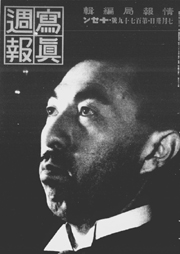 |
 |
The third Konoe Cabinet was launched without Matsuoka. However, amid the further deterioration in relations with the United States following the stationing of Japanese troops in southern French Indochina on July 28, 1941, the Cabinet resigned en masse on October 16, 1941.
Konoe was designated as a suspected war criminal after Japan’s defeat in 1945. That December he committed suicide by taking poison. |
 |
| |
